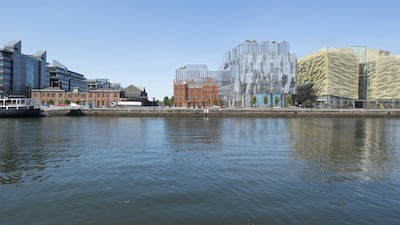A consensus is emerging around the hybrid workforce of the post-pandemic future, one that combines office and home-based working. But how will it work?

The Ireland-US Business special report looks at how American companies continue to expand and develop their workforces here, and how encouragement can be found in the level of job creation being seen in parts of the economy.
[ The Irish Times ePaperOpens in new window ]
As deputy head of architecture at Ireland's PM Group, a multinational company delivering complex facility design and construction management projects to clients worldwide, Shauna Sweeney is well placed to know.
“Connectivity and inclusivity are going to be important. At present, because of working from home, everyone is more or less in the same boat. As we see a staged return to work, a new hybrid model will emerge, and the question for clients is how can we ensure that dynamic works? As experts in workplace design, we are looking at the types of space that organisations will need to facilitate this,” she explains.
Expected digitally enhanced offices and meeting rooms to facilitate that, including new platforms including whiteboards and screens so that everyone at home sees exactly what people in the office see too. “That’s going to be very important for diversity and inclusion in the future,” she says.
One of the lessons of the pandemic, for employees as well as for employers, is that people like to work in different ways. That too will have to be accommodated in a blended future.
“It’s part of diversity and inclusion, but everyone likes to work differently and has gotten used to being able to do so while working from home. So, for example, some like to work at the kitchen table in the morning but move into a room in the evening.”
That desire for change will be reflected in offices with, for example, a shift from traditional refectory style canteens into more cafe-style seating, so that people can work there too if they choose.
“Someone coming in for a bunch of meetings doesn’t need a desk all day, just a place to do emails for half an hour, so variety, more flexibility in terms of workspaces and simply more choice is going to be important,” she says.
Sweeney has worked for years with clients who wanted to introduce more agile, flexible ways of working but found it a struggle getting employees to buy in. “The pandemic has given people time to adapt to it. They know now that it works for them,” she says.
The pandemic has put wellbeing front and centre for both employers and employees, and this will not change as the threat of Covid recedes.
“Wellbeing has moved to the forefront now and companies will require etiquette to manage it, even down to simple things like a policy not to have lunch time meetings and ending video calls five minutes before the hour so people can get toilet breaks.”
It includes workplace design, such as how desks are placed in relation to natural light, introducing sit-stand desks, and general ergonomics. Employers have always had a duty of care but expect employers of choice to introduce new innovations such as screens and sensors that monitor the internal atmosphere and air and water quality too, for example.
Being able to offer remote working gives organisations access to a wider talent pool, including those who can't or don't want to do a long commute, points out Jeff Green, employment and benefits partner at law firm William Fry.
He believes full time remote working will be less prevalent than hybrid working which will see people having to attend the office one or two days a week.
That’s because, when it comes to managing a remote workforce, surveys suggest employers are less concerned about issues such as productivity and employee satisfaction than they are about maintaining corporate culture and morale. “One compulsory day a week in the office is a good way around that,” he suggests.
In cases where employees are still remote working in inappropriate spaces, such as sitting on couches or using ironing boards as desks, such issues will need to be addressed. An employer’s duty of care doesn’t disappear in a pandemic, he points out.
Employers should undertake remote safety assessments to check for poor ergonomics and provide staff with written guidance about how best to protect themselves, encouraging them to come forward for help if they develop issues with their back or shoulders.
Putting in place a buddy system for mental health, similar to that when a person joins an organisation, can also help, he suggests.
“We have seen the benefit of a greater work life balance, but the flip side of remoting can be where people end up working late in the evening and struggling to switch off. A right to disconnect was put through at speed as a result of the pandemic,” he points out.
One of the advantages of remoting for workers has been the ability to relocate somewhere where accommodation is more affordable. In some cases that has seen staff heading – or returning – overseas.
But managing employees who are remote working abroad can give rise to additional challenges for employers.
“It could have employment law consequences if someone wants to work from France or Germany say, even if they are under an Irish employment contract,” he points out.
It may also create tax issues if they are deemed to have created a permanent establishment in that country, so take advice.
If you haven’t already put a hybrid working policy in place, don’t delay. The pandemic may be abating but remote working is only getting started. “A key part of the Government’s National Remote Work Strategy will be legislating for a right to request remote working,” he says.












